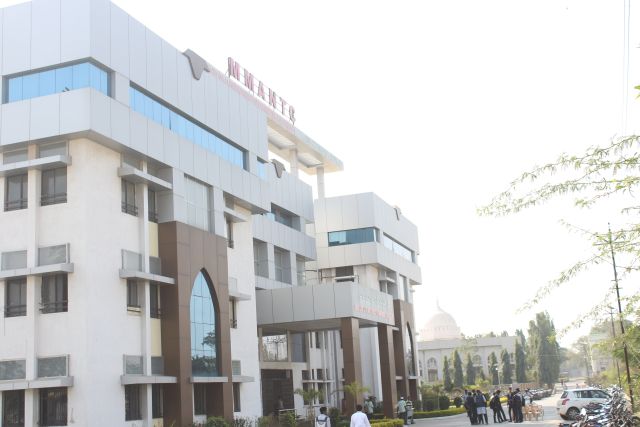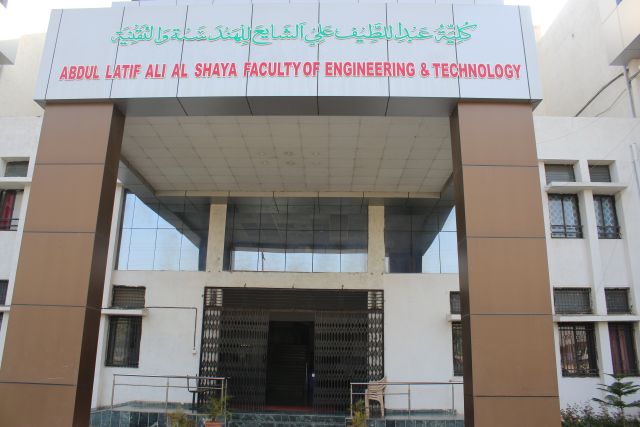
by admin | May 25, 2021 | Business Summit, Entrepreneurship, Events, Social Entrepreneur, Women Entrepreneur, Your Business Plan

Rashid Mukhtar
“To promote innovation, entrepreneurship, and awareness especially amongst female and rural students”
By Maeeshat News,
Malegaon, Maharashtra: Maulana Mukhtar Ahmed Nadvi Technical Campus (MMANTC) to organize and host their 1st National Conference on Technology to promote the innovation, entrepreneurship, and awareness especially amongst female students and rural students at MMANTC, Mansoora Malegaon on 23rd & 24th Feb 2019. The conference aims to bring together researchers, scientists, industry experts, academicians and policy makers to promote STEM, and specially promote & encourage women’s participation in STEM.
Honorable Rashid Mukhtar, Secretary JMES, said that “Our founder’s vision was to empower the youth of India through quality technical education. Through our conferences such as 1st National Conference on Technology we want to connect our students with Industry and skilled masters of the industry for their professional career and entrepreneurship journey.”
As one of the aims of the conference is to promote women’s participation in STEM, the organizers have invited Ainul Attar who is Former, Deputy Director DTE, Former, Joint Secretary of Minority Development Department, Government of Maharashtra, Ex-Executive council member of I.S.T.E., New Delhi as a Chief Guest to inspire the rural girl students.

Side view
MMANTC have also invited Dr. Tausif Malik, Treasurer, Democrats Abroad India (Democratic Party USA’s International chapter), Founder MAHAbfic.com (Maharashtra Blockchain Fintech ICO Crypto currency) Pune, GCCStartup.News, All India Muslim Business Startup Network (AIMBSN), IndiaStartupFest.com, Muslim Spelling Bee, USA, Chicago as Chief Guest. He believes in the Gandhian Philosophy of empowerment of Rural India through sustainable development through Future Technologies. The sole objective is to promote and create a talent pool in Future Technologies creating sustainable development through “Reverse Migration”. He is a legend in his field and students will surely be benefited with his presence.
The MMANTC has also invited dignitaries such as Prof. (Dr.) N. B. Pasalkar Sahab, Dr. A. K. Kureshi, Dr. Neha Dand, Shahzed Lehry and Altaf Pirjade.
Dr. Munnazza Afreen, Chief Convener & Head, Faculty Training & Development; said that “Females participation in Technology and entrepreneurship is very low and through the conference we want to promote the same to our students, attendees and well-wishers.”
Dr. Munnazza Afreen further added that we want our students to benefit from the Government of India schemes such as Make in India, Digital India, and Skill India & Startup India.
Conference specifically focuses on publication with our publication partner IOSR Journal, JMES Startup Showcase, JMES Hackathon, networking, branding and most importantly campus recruitment of college students.
The conference organizers are seeking Sponsorship, Media Partnership, Applications & Judges for JMES Hackathon, Applications, Investors & Judges for JMES Startups Showcase, Strategic Partnerships for Recruitment & Internship opportunities. They can contact me via Email facultydevelopment.jmes@gmail.com.

Front gate
About MMANTC
Maulana Mukhtar Ahmed Nadvi Technical Campus (MMANTC) is located at the outskirts of Malegaon, the textile township of northern Maharashtra. The college offers Degree and Diploma courses in Mechanical, Civil, Electrical and Electronics and Telecommunication Engineering since 2012.
The Technical Campus has been a dream project of the Society’s President, Maulana Arshad Mukhtar, a great visionary, philanthropist, industrialist, educationist, and a worthy son of a worthy father, Maulana Mukhtar Ahmad Nadvi, who founded Jamia Mohammediya Education Society (JMES) in the year 1978. JMES has twelve institutions running in various parts of the country. Maulana Mukhtar Ahmad Nadvi strongly believed that only through education would the people of India, gain the vision of the future while preserving their timeless cultural values. Maulana Arshad Mukhtar, having taken the mantle from him in the year 2007, has been painting the canvas with such elegance that Jamia Mohammediya Education Society is now a name in the country to reckon with.
For further details please contact
Dr. Munnazza Afreen,
Chief Convener Head, Faculty Training & Development JMES, Mansoora
Email: facultydevelopment.jmes@gmail.com
Mobile: +91 9930786821
http://www.mmantc.in/events/conference-technology-1/
For Registration
https://www.onlinesbi.com/sbicollect/icollecthome.htm?corpID=934644

by admin | May 25, 2021 | Markets, Social Media, Technology, World
 San Francisco : With efforts to reform a European Union tax law not bringing the desired results, France is going to introduce from January 1, 2019 a digital tax on technology giants such as Google, Facebook, Apple and Amazon, the media reported.
San Francisco : With efforts to reform a European Union tax law not bringing the desired results, France is going to introduce from January 1, 2019 a digital tax on technology giants such as Google, Facebook, Apple and Amazon, the media reported.
The French government’s “GAFA” tax” is being introduced to combat attempts by the firms to avoid paying what is considered a “fair share” of taxes in the country, by taking advantage of European tax laws, Appleinsider reported on Monday.
The new tax regime is expected to bring in an estimated 500 million euro ($570 million) to the country’s cofferes for 2019, according to French Finance Minister Bruno Le Maire, The Local Fr said in a report.
Major technology companies have come under the scrutiny of lawmakers in countries like France and Britain for allegedly routing profits through operations in countries with extremely low tax rates or other arrangements.
Earlier this year, the European Commission published proposals for a three per cent tax on the revenues of major tech companies with global revenues above 750 million euro a year and taxable EU revenue above 50 million euro, the BBC reported.
But to become law, EU tax reforms need the support of all member states. And some countries, including Ireland, the Czech Republic, Sweden and Finland are yet to come on board to bring the reforms.
—IANS

by admin | May 25, 2021 | Branding, Business, Marketing Basics, Markets, SMEs, Technology
 By Rachel V. Thomas,
By Rachel V. Thomas,
Seoul : Samsung, a global leader in display technology, is confident of coming up with an industry-leading display technology in its next flagship smartphone, a top executive said here on Wednesday.
According to Harksang Kim, Senior Vice President and Head of Mobile Visual R&D at Samsung Electronics, the company’s next flagship smartphone will have industry-leading, screen-to-body ratio.
This is in line with recent media leaks that the tech giant’s anniversary edition Galaxy flagship will be almost bezelless.
“Samsung is focused on enhancing the size of the display and, importantly, the ratio of the active area on the handset,” said Kim, adding that “our screen-to-body-ratio will be top notch”.
On foldable displays, Kim pointed out that Samsung has been developing the technology since the last four years.
“We have been working on foldable display for the last four years. But we are not focusing so much on the foldability itself but on benefits it can offer beyond a bigger display. We want to offer something beyond tablets in terms of application and solutions,” Kim stated.
He noted that the focus is on security and stability of foldable hardware as simply making a foldable display is not an innovation but just another method for providing a larger screen.
The South Korean tech giant also wants to focus on consumers’ ease of use and convenience.
“By next month, you will hear some official announcements by Samsung Electronics not just on hardware development but also on software and platform preparations as well,” the executive informed.
While Samsung smartphones currently provide two solutions for personal identifications — fingerprint recognition and iris scanning — the company is also working on optical fingerprint recognition sensors.
However, since personal identification is directly linked to personal information and brings potential risks to the consumers, the tech giant is trying to be careful.
“Although we know that there may be delays, we are reviewing optical solutions in terms of in-display finger recognition tech and other solutions,” Kim said.
On cameras, in the future models, the rear cameras will be developed to see beyond what the human eyes can see.
“From the hardware perspective, few years down the road, we believe that rear cameras with their DSLR technology are not just going to capture the environment or nature but beyond what the human eye can see.
“Fundamentally, the rear facing camera technology will be all about communications. For example, when I’m not available, my Augmented Reality (AR) emoji will be communicating on my behalf,” Kim said.
(Rachel V. Thomas is on a visit to Samsung Headquarters at Seoul. She can be contacted at Rachel.t@ians.in)
—IANS

by admin | May 25, 2021 | Markets, Opinions, Technology
 By Amit Kapoor,
By Amit Kapoor,
The world stands on the brink of the Fourth Industrial Revolution, powered by a wide range of new technology breakthroughs — Artificial Intelligence, Machine Learning, advanced robotics, Internet of Things, cloud computing and 3D printing — and the revolution is expected to result in major changes in the labour market globally by reducing the demand for middle-skilled workers doing repetitive tasks, and increasing the demand for more highly-skilled workers and also low-skilled workers doing non-routine work.
While many developed countries, such as the US, Japan and several European economies, are already experiencing this labour market polarisation, the market is also hollowing out in many developing countries — although at a rate slower than the developed world (World Development Report, 2016).
In India’s case, this polarisation can be seen in the organised manufacturing sector, where the share of high-skilled occupations in total manufacturing employment increased by more than three percentage points, while the share of middle-skilled jobs decreased by 6.3 percentage points from 1993-94 to 2011-12. Looking at the impact of technological progress on various manufacturing industries in India, capital-intensive industries — automobile manufacturing, for instance — have a greater probability of adopting advanced automation and robotic technologies, compared to the labor-intensive manufacturing industries such as textile, apparel, leather, and footwear, and paper manufacturers.
Further, in the services sector, particularly in the IT sector, e-commerce, banking and financial services and health care services, there is a huge potential for automation technologies, which would increase the demand for skilled workers and reduce the demand for middle-skilled workers.
However, in India, over 80 percent of the working population is engaged in low-skilled jobs in the unorganised sector. These workers aspire to join the middle-skilled workforce in the organised sector to raise themselves from poverty. However, the changing nature of work due to technology advancements in the organised sector prevents their upward mobility and any improvement in their incomes.
Addressing the challenges induced by technological advancements requires reforms in India’s higher education system. The institutes of higher learning should redesign the course curriculum by understanding the key market transitions amidst the technological advancements. This would enable the country to create a workforce which could be placed in the positions demanded by the companies in the digital era and thus bridge the skill gap in the labour market.
However, looking at the current state of higher education in India, one can perceive that it is not just the quality of the system which needs to be improved, there is also much to be done in terms of the number of students enrolled in institutes of higher learning and heterogeneity existing in access to higher education based on socio-economic status, gender and also region. The Gross Enrollment Ratio (GER) in tertiary education in India is 26.9 per cent, which is lower than that of China (48.4 per cent), Indonesia (27.9 per cent) and the Philippines (35.3 per cent), among others.
Further, the GER in India for the male population is 26.3 per cent and 25.4 per cent for females. The GER also varies across different social groups. For the Scheduled Castes it is 21.8 per cent and 15.9 percent for the Scheduled Tribes.
There are also wide variations in the number of colleges for higher education across different states in India, with the lowest number of seven colleges in Bihar for every 0.1 million of eligible population to 51 in Telangana and Karnataka. The top eight states in terms of highest number of colleges in India are Uttar Pradesh, Maharashtra, Karnataka, Rajasthan, Andhra Pradesh, Tamil Nadu, Gujarat, and Madhya Pradesh, which have 28 or more colleges per 0.1 million of the population.
The disparity in the distribution of the colleges is also seen across different districts in these states, with the top 50 districts having about 32.6 per cent of the colleges.
In addition to the inequalities existing in the access to institutions for higher education, another issue with the state of higher learning in India is that a majority of the students are enrolled in undergraduate programmes, compared to masters and the doctoral programmes. Moreover, at the undergraduate level, there is a low pass out rate of the students — of the 2,90,16,350 students enrolled, the number of pass outs have been 64,19,639 in 2017.
Given that the Indian system of higher education faces multiple challenges of low gross enrollment in its colleges and universities, with most students settling on undergraduate studies, along with various socio-economic inequalities existing in access to higher learning, it is imperative for the country to address these issues.
Further, emphasis must be given on increasing the number of students who pass out of colleges/universities, along with increasing enrollment numbers.
The technology-induced skill gap which the Indian economy is facing across its different sectors is bound to increase with the given higher education system. The change has to be brought from outside the existing constructs. Improvement in the teaching methodology from the traditional lecture courses, accreditation of online courses and redesigning the course curriculum to make it industry-relevant are some of the ways the technology-led changes in the labor market can be dealt with.
(Amit Kapoor is chair, Institute for Competitiveness, India. The views expressed are personal. He can be contacted at amit.kapoor@competitiveness.in and tweets @kautiliya. Deepti Mathur, senior researcher at large with Institute for Competitiveness, has contributed to the article)
—IANS

by admin | May 25, 2021 | Corporate Jobs, Employment, Entrepreneurship, Markets, Online Marketing, Technology
 By Ishan Gupta,
By Ishan Gupta,
Rapid developments in technology require professionals to upgrade their skills for technology-centered jobs of tomorrow
Srikanth Vidapanakal, who has been into data for more than 18 years, was inquisitive to learn about new technologies. He did a Self-Driving Car Engineer Nanodegree that helped him acquire advanced skills and landed him with a job in automation sector. Srikanth is an example of lifelong learning where staying relevant in the age of rapidly changing technologies is the need of the hour.
In 2017, research suggested that AI and robotics could collectively take over 800 million jobs worldwide by 2030. On the flipside, it also mentioned that the technological revolution will end up creating millions of new jobs. In order to stay relevant and keep their jobs in the changing global job landscape, technologists and professionals from diverse fields will be required to upskill themselves Keeping yourself abreast with emerging technologies will constantly keep you ahead of the game.
Here are 5 skills that, if acquired, can keep you relevant in the transforming global job market of tomorrow:
Machine Learning: Machine Learning entered the technological arena as a game-changer that enabled multifaceted software to become more competent at tasks without the need for repeated programming. Machine Learning allows computers to read and interpret large data sets to derive essential insights. This learning can further be applied to complex data models in order to create predictions and compare trends for the future. Machine Learning can also enable algorithms to track data and identify weak links in any process or system, thereby optimizing them to their highest level of productivity and efficiency.
Deep Learning: Deep Learning is a part of Machine Learning which is based on the Neural Network architecture. Neural networks are extremely advanced programming codes that seamlessly mimic the architecture of neurons of the human brain. Through Deep Learning, software can identify and configure patterns from data or images much more proficiently. By identifying patterns in data, Deep Learning can be utilized to create more efficient Natural Language processors that can be used to write more responsive chatbots.
Blockchain: Blockchain technology evolved with the purpose of appending data security and information privacy to cryptocurrency Bitcoin. Today, the robust mechanism has found applications in securing digital payments, smart contracts, cybersecurity, digital IDs copyright protection and data sharing. Given the exceptionally versatile nature of blockchain applications, blockchain technology experts are high in demand in the job market. Jobseekers with blockchain skills bag the 4th highest salaries in India which makes it one of the most sought after job by Indians and professionals around the world.
Robotics and Automation: Both robotics and automation are essentially reducing human labor and proliferating safety of humans by taking over dangerous, physically demanding tasks. Robots can easily lift heavier weights and tolerate high temperature working environments more than human workers possibly can. Robotics has quickly clocked in the highest potential among any other applications of Artificial Intelligence. With Machine Learning at the heart of AI, robots that already outperform humans at the physical level will also be able to undertake a variety of laborious tasks such warehousing and security.
Self-Driving Cars: For more than a 100 years, motor vehicles have been an integral part of human existence. Since its inception, the motor vehicle has gone through umpteen updates that have led to the invention of the modern and inherently secure vehicle. However, road accidents have continued to cause loss of property and life. These fatal accidents can be attributed not to technology but to human negligence or error, leading to the need for replacing the human driver. With cutting-edge robotics, Machine Learning, and engineering, humans have been able to create self-driving cars. These driverless vehicles are appearing to be exponentially more efficient at avoiding collisions and accidents.
(Ishan Gupta is MD India of Udacity, Silicon Valley-based lifelong learning platform)
—IANS







